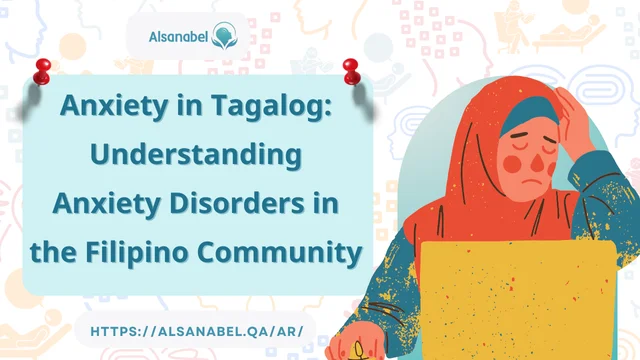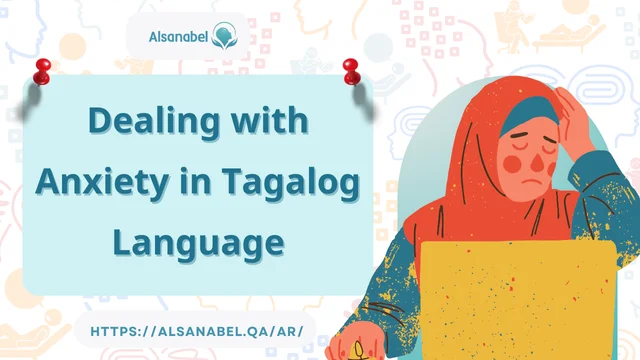
Anxiety in Tagalog, or “pag-aalala” or “kabalisahan,” is a common mental health condition that affects many individuals in the Filipino community, both in the Philippines and abroad. Anxiety disorders can manifest in various forms, such as excessive worrying, fear, or panic, and can significantly impact daily life. However, understanding these disorders in the context of Filipino culture and language is essential for offering appropriate support and treatment.
In this article, we will explore the meaning of anxiety in Tagalog, the causes, how to manage anxiety, and how mental health services in places like Qatar can help members of the Filipino community.
Anxiety in Tagalog: Meaning and Cultural Context
Anxiety in Tagalog, often expressed as “kabalisahan,” refers to the feeling of worry, nervousness, or unease, especially about something with an uncertain outcome. The word “pag-aalala” is also used to describe general feelings of worry or concern. In Filipino culture, anxiety is often seen as a response to stress, family pressures, work challenges, or financial problems.

Culturally, Filipinos tend to prioritize close-knit family relationships and community values. While these relationships offer a strong support system, they can also lead to additional stress, especially when individuals feel pressured to meet societal expectations or take on burdens for the well-being of others. For many Filipinos living abroad, such as in Qatar, adapting to new environments can intensify feelings of anxiety due to homesickness, isolation, and adjusting to cultural differences.
Common Causes of Anxiety in Tagalog
There are several causes of anxiety in Tagalog, or “mga sanhi ng kabalisahan.” Some of these causes are deeply rooted in Filipino cultural and societal norms, while others may be related to specific life circumstances:
- Family Expectations: In the Filipino culture, there is often a strong sense of duty and obligation to provide for one’s family. This pressure can lead to significant stress, especially for overseas Filipino workers (OFWs) who are separated from their families but still bear the financial and emotional burdens.
- Financial Struggles: Economic challenges, particularly for those living in poverty or trying to support large families, can contribute to constant feelings of worry and insecurity.
- Work-Related Stress: Many Filipinos working abroad in countries like Qatar face high-pressure work environments, language barriers, and cultural adjustments, all of which can contribute to anxiety.
- Social Pressure: In Filipino culture, there is an emphasis on maintaining a positive image in the community, which can lead to stress and anxiety about not meeting social expectations or experiencing shame.
- Health Concerns: Worrying about health, especially when family members back home are unwell or lack access to medical care, can cause significant anxiety.
How to Manage Anxiety in Tagalog
How to manage anxiety in Tagalog, or “kung paano pamahalaan ang kabalisahan,” can involve several approaches, both modern and traditional. Understanding anxiety in the context of Filipino culture means incorporating culturally sensitive strategies for dealing with it.
1. Family Support
For Filipinos, family plays a crucial role in mental health. Reaching out to family members for emotional support and sharing personal worries can help reduce feelings of isolation. Maintaining close ties with loved ones, even from afar, can be a source of comfort and help manage stress and anxiety.
2. Mental Health Services in Qatar
For Filipino workers living abroad, access to mental health services in Qatar is essential for managing anxiety. There are various counseling and therapy options available, often provided by mental health professionals like Dr. Sanabel Al Akras who understand the cultural needs of the Filipino community. These services can offer guidance on coping strategies and support systems, helping individuals manage anxiety more effectively.
3. Traditional Practices and Faith
Many Filipinos turn to their faith when dealing with anxiety. Praying and attending religious services can provide a sense of peace and grounding. In addition, traditional Filipino practices such as meditation, herbal remedies, and seeking advice from elders or spiritual leaders can complement more formal medical approaches to managing anxiety.
4. Exercise and Relaxation Techniques
Physical activities like exercise, yoga, or even simple relaxation techniques like deep breathing can help alleviate the physical symptoms of anxiety. These practices are becoming more popular within Filipino communities as more people recognize the benefits of taking care of both mind and body.
5. Professional Counseling
Seeking professional counseling at Al Sanabel Specialized Psychiatric Center In Qatar is an important step for anyone struggling with severe or persistent anxiety. Filipino individuals living abroad can benefit from seeing a counselor who speaks their language or understands their cultural background. Online therapy platforms can also provide accessible mental health services for those who may not have local resources.
Dealing with Anxiety in Tagalog Language
Dealing with anxiety in Tagalog language, or “pagharap sa kabalisahan,” requires not only personal coping strategies but also understanding how anxiety is viewed within the community. For many Filipinos, there can be a stigma attached to seeking mental health support, as mental health issues are often misunderstood or downplayed. This makes it even more crucial to raise awareness about anxiety disorders and encourage open conversations about mental health.

Anxiety in Tagalog FAQs
1. How do you say anxiety in Tagalog?
In Tagalog, anxiety is translated as “kabalisahan” or “pag-aalala.” These terms capture the feelings of worry, unease, or stress that accompany anxiety.
2. What are the common signs of anxiety in Tagalog?
Common signs of anxiety include “hindi mapakali” (restlessness), “pag-aalala” (worry), “pagod” (fatigue), difficulty sleeping, and physical symptoms like a racing heart or trembling. Emotional signs may include irritability, fear, and difficulty concentrating.
3. How is anxiety treated in the Philippines?
In the Philippines, anxiety is often treated through a combination of modern medical approaches like therapy and medication, as well as traditional practices such as prayer and support from family. Access to mental health professionals is improving, and many seek help from counselors or psychologists for guidance.
4. What are common causes of anxiety in Filipino culture?
Common causes of anxiety in Filipino culture include family expectations, financial stress, work-related pressures, social expectations, and concerns about health. For overseas workers, homesickness and adapting to a new environment also contribute to anxiety.
5. Are there Filipino-specific approaches to managing anxiety?
Yes, Filipino-specific approaches to managing anxiety include relying on family support, turning to religious faith, and using traditional remedies or practices. These are often combined with modern mental health services to provide comprehensive care.
Anxiety in Tagalog is a condition that affects many people within the Filipino community. Understanding the causes of anxiety in Tagalog and finding culturally appropriate ways to manage it are crucial for improving mental health. Whether through traditional support systems, religious faith, or modern therapy, managing anxiety requires a holistic approach that takes into account the unique cultural context of Filipinos. For those in Qatar, mental health services are available to provide the necessary support, ensuring that individuals can maintain their well-being while living abroad.
